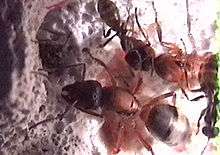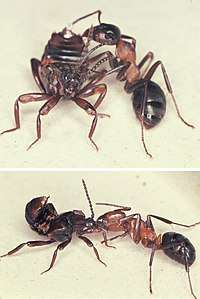Formica sanguinea
Formica sanguinea, or blood-red ant, is a species of slave-maker ant in the genus Formica characterized by the ability to secrete formic acid. It ranges from Central and Northern Europe through Russia to Japan, China, the Korean Peninsula, Africa and also the United States.[1] This species is coloured red and black with workers up to 7 mm long.[2]
| Formica sanguinea | |
|---|---|
| Scientific classification | |
| Kingdom: | Animalia |
| Phylum: | Arthropoda |
| Class: | Insecta |
| Order: | Hymenoptera |
| Family: | Formicidae |
| Genus: | Formica |
| Species: | F. sanguinea |
| Binomial name | |
| Formica sanguinea Latreille, 1798 | |
A colony of F. sanguinea can live either as a free colony or as a social parasite of Formica species, most commonly Formica fusca, "Formica japonica", "Formica Hayashi" and Formica rufibarbis.[3]
Slave-making

F. sanguinea, are facultative slave-makers, meaning colonies can live either alone or be parasitic. This allows them to be a good model organism to study the origins of ant slave-making.[3] A fertilized F. sanguinea queen will enter the nest of the host ant species and kill their queen. She then takes advantage of the workers who tend to her and her brood. F. sanguinea workers will also raid nearby nests, stealing larvae and pupae to become future workers for F. sanguinea. The raids are also not exclusively for acquiring slave workers but are sometimes predation events.[4]
F. sanguinea has not been observed to have division of labor in which certain individuals raid or forage.[5] This excludes them from the eusocial groups of Hymenoptera. However, some individuals possess more Dufour's gland compounds than others, which presumably would be more successful in slave raids.[3]
Formica sanguinea uses scouting individuals to locate the nest that will be parasitized. Once a nest has been scouted, the raid will happen. The activities that go on during a raid are composed of digging and fighting at the target nest. Both slaves and slave-makers are observed to be carrying the brood back to the slave-maker nest. If a member of the colony is killed in the war, individuals will take that carcass back to the nest to be eaten later. Raids were also never observed on rainy or overcast days. This is thought to be because of the detriment rain might have on terrestrial conditions and the effectiveness of alarm pheromones.[3]
Chemical defenses
F. sanguinea uses formic acid as well as substances in the Dufour's gland as chemical defence.[6] The substances in the Durfour's gland contain hydrocarbons such as hendecane, as well as acetates, decylacetate, and dodecylacetate.[6] Formica sanguinea uses the formic acid and Durfour's gland substances in conjunction with each other. The hydrocarbons in Durfour’s substance serve as a wetting before the formic acid is released. Without these wetting agents, formic acid is relatively harmless to other ants. These substances dissolve the fat compounds of the epicuticle as well as enter the tracheal system to kill the opponent.[6]

Reproduction
Most colonies are monogynous, meaning they have only one queen. F sanguinea are commonly polyandrous, meaning the singular queen mates with more than one male. In studies observing this, 70% of queens mated with multiple males.[7] F. sanguinea is observed to have higher levels of polyandrous than any other Formica species. However, when colonies engage in polygyny, having more than one queen, the rates of polyandry drop. It is assumed that colonies utilize either polyandry or polygyny, to increase the genetic diversity of the colony. Therefore, two different strategies can be employed.[7] One strategy is that a female mates with many males and then disperses to start a new colony. The second strategy is for a female to mate with a fewer number of males, and stay close to the natal colony with other females who have mated with a fewer number of males. In the case of polygyny, it has been observed that there is one dominating queen who is more sexual reproductive than the others.[7] Formica also is observed to have a paternity skew, meaning that the mated males offspring are not represented equally in the population. Whether this is because of internal selection or sperm competition is unclear.[7]
Recognition of individuals
F. sanguinea analyzes hydrocarbons on the cuticle of another individual to determine if it is an intruder. Low intraspecific competition and aggressiveness is observed in this species. When members of the same species of a mixed colony were met with individuals from a pure F. sanguinea colony, they were met with aggressiveness. This is most likely because the identifying hydrocarbons change when individuals are in a mixed colony.[8]
References
- Topoff, H.; Zimmerli, E. (1991). "Formica wheeleri: Darwin's Predatory Slave-Making Ant?". Psyche: A Journal of Entomology. 98 (4): 309. doi:10.1155/1991/34829.
- Sonobe, Rikio; Onoyama, Keiichi. "Formica sanguinea". Archived from the original on 2003-06-10. Retrieved 2007-12-18.
- Mori, A.; Grasso, D. A.; Le Moli, F. (2000). "Raiding and Foraging Behavior of the Blood-Red Ant, Formica sanguinea Latr. (Hymenoptera, Formicidae)". Journal of Insect Behavior. 13 (3): 421. doi:10.1023/A:1007766303588.
- "Wood Ants". 1999. Archived from the original on 2012-07-06. Retrieved 2007-12-18.
- Kharkiv, V.A. (1995) "Effectiveness of activity and division of labor between slaves and slavemakers in colonies of Formica sanguinea (Hymenoptera, Formicidae)". Institute of Animal Systematics and Ecology, Russian Academy of Sciences, Novosibirsk, Russia
- Lofqvist, J. (1977). "Toxic properties of the chemical defence systems in the competitive ants Formica rufa and F. sanguinea". Oikos. 28: 137–15. doi:10.2307/3543333. JSTOR 3543333.
- Haapaniemi, K; Pamilo, P (2012). "Reproductive conflicts in polyandrous and polygynous ant Formica sanguinea". Molecular Ecology. 21 (2): 421–30. doi:10.1111/j.1365-294X.2011.05386.x. PMID 22133095.
- Włodarczyk, T. (2011). "Recognition of Individuals from Mixed Colony by Formica sanguinea and Formica polyctena Ants". Journal of Insect Behavior. 25 (2): 105. doi:10.1007/s10905-011-9280-x.
External links
